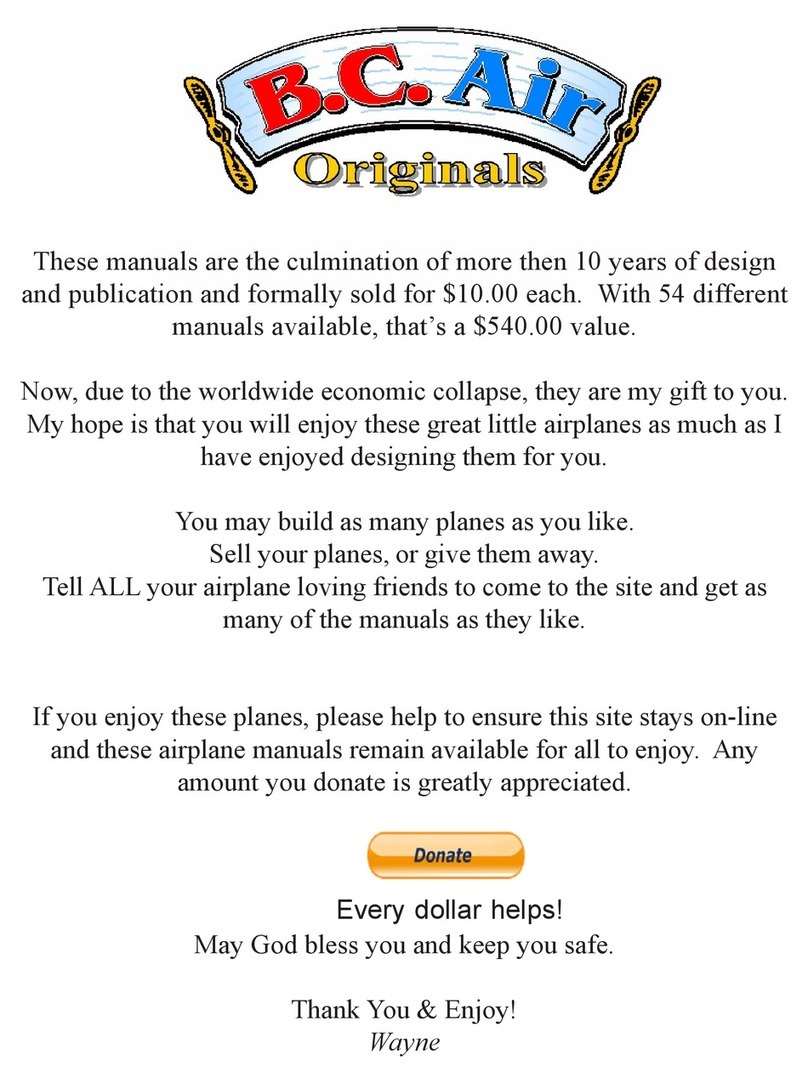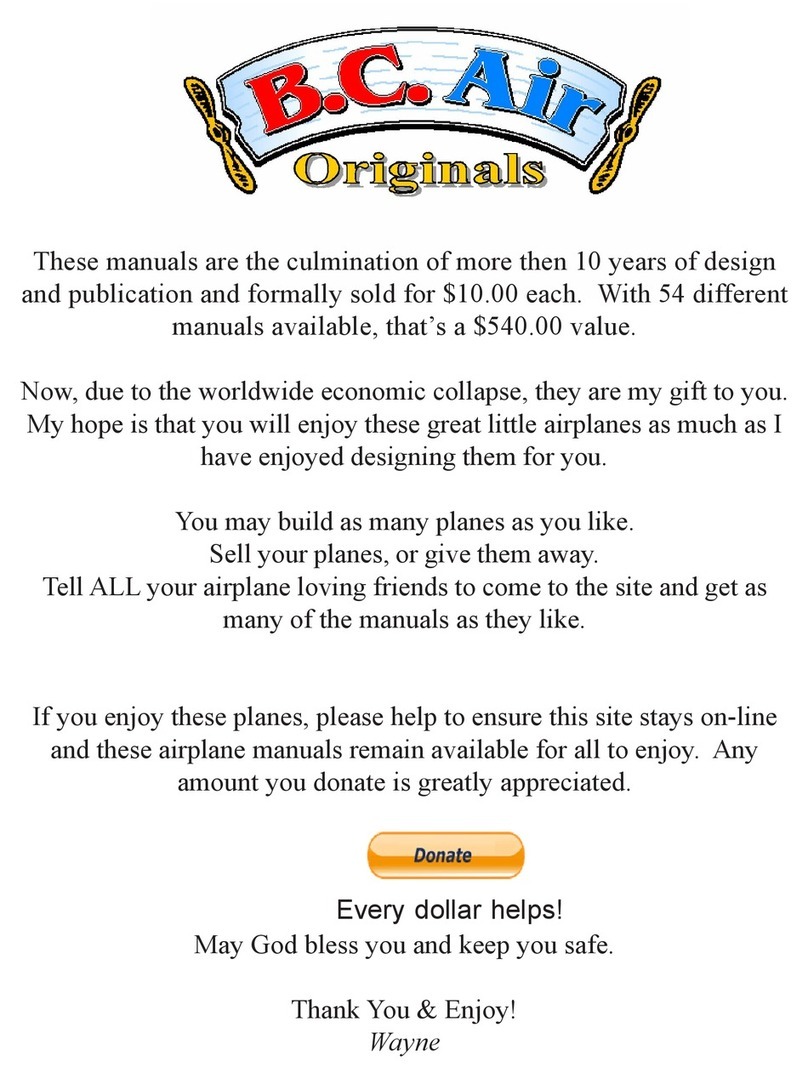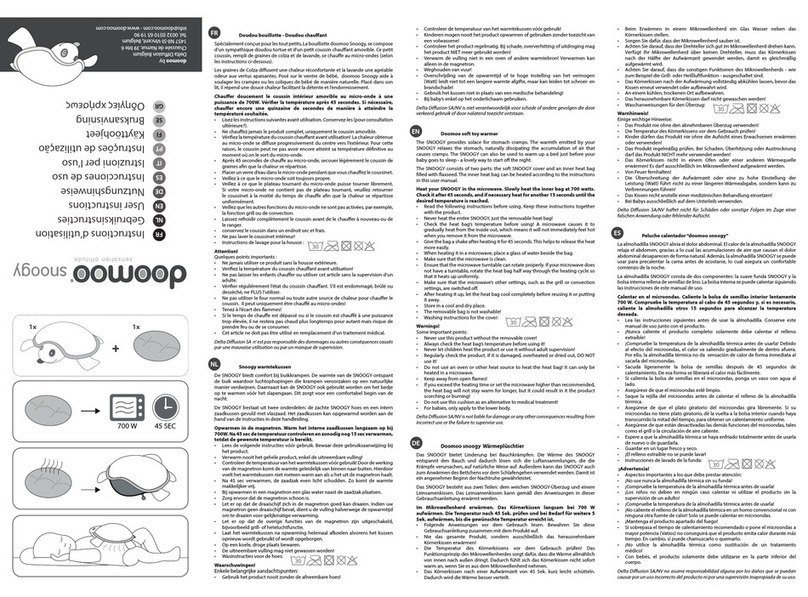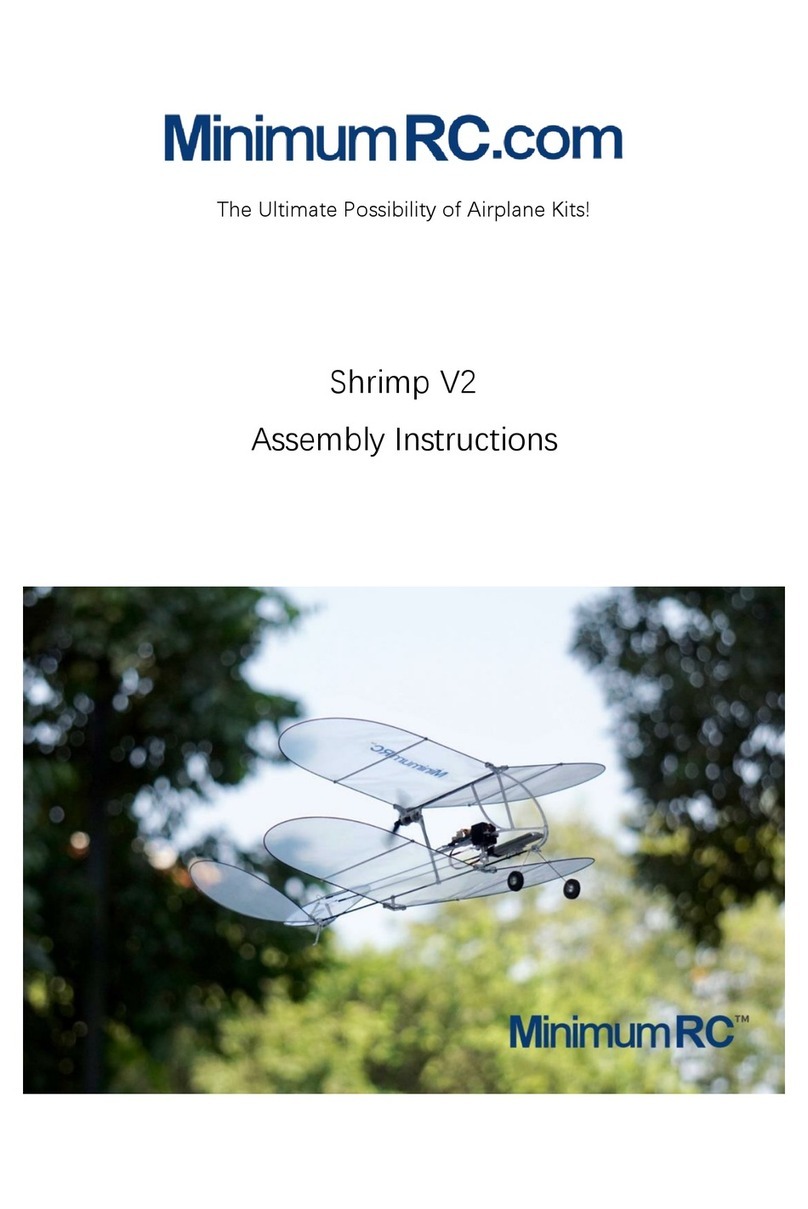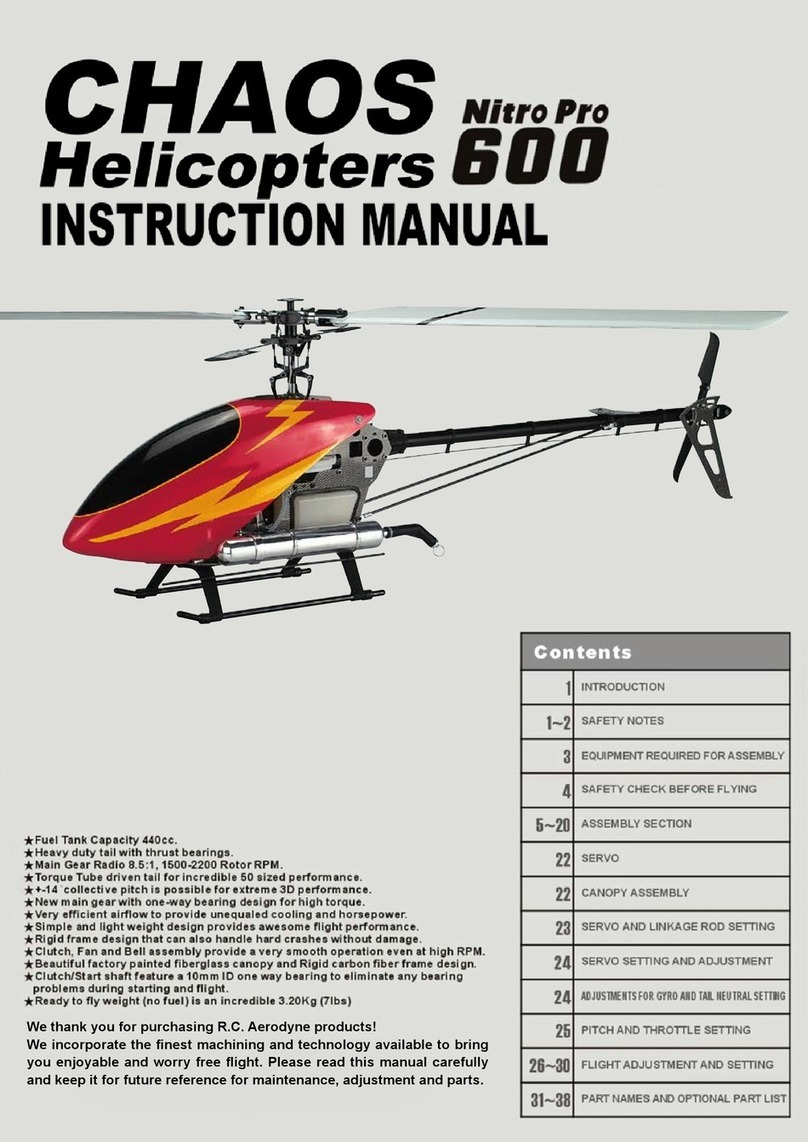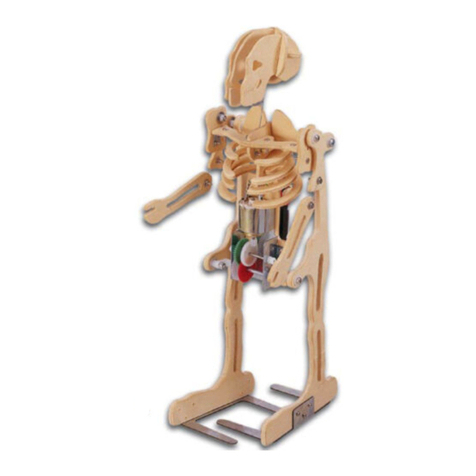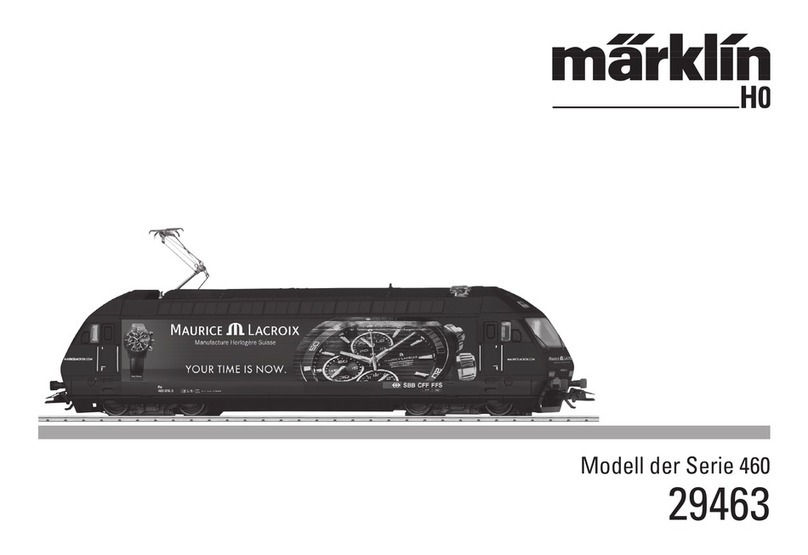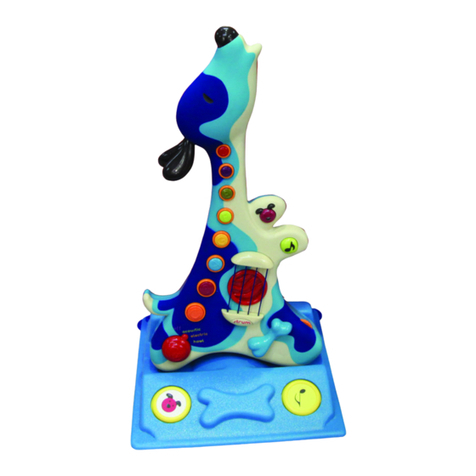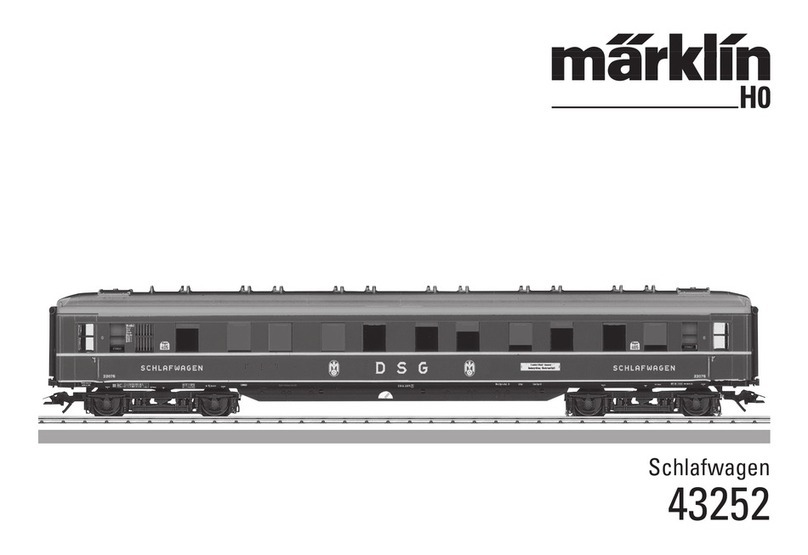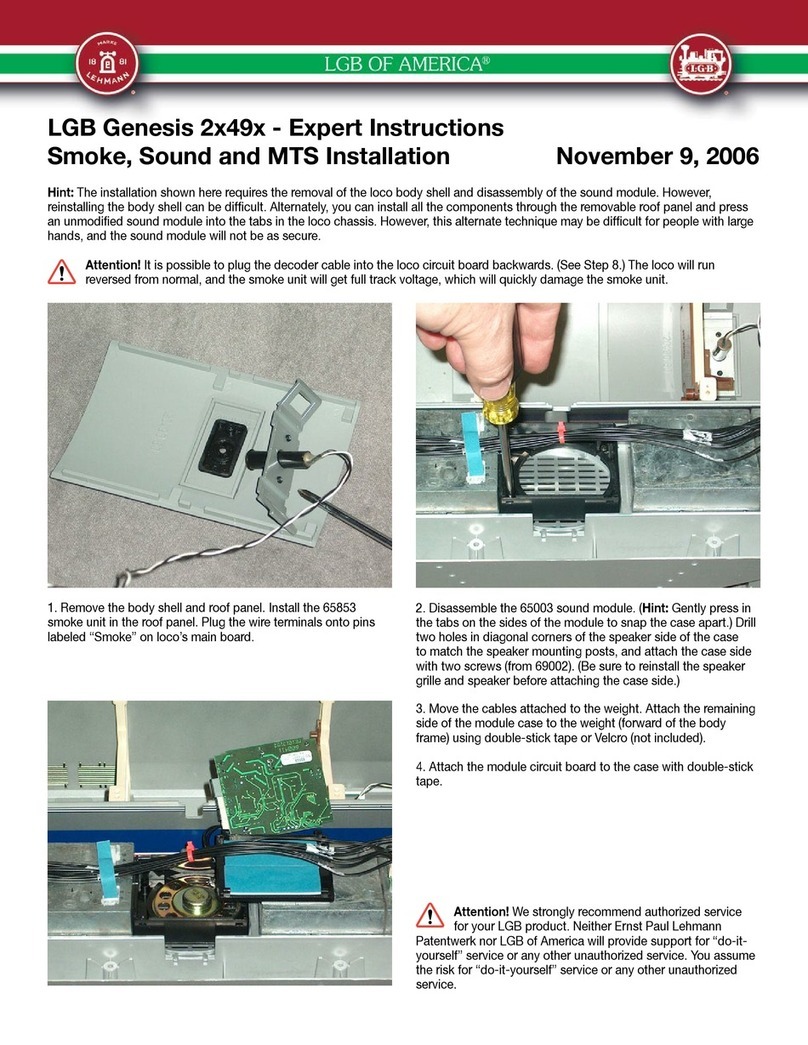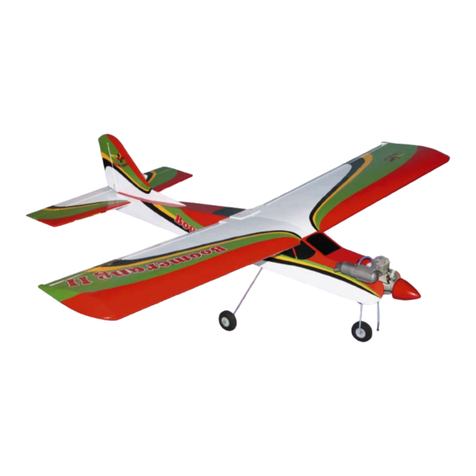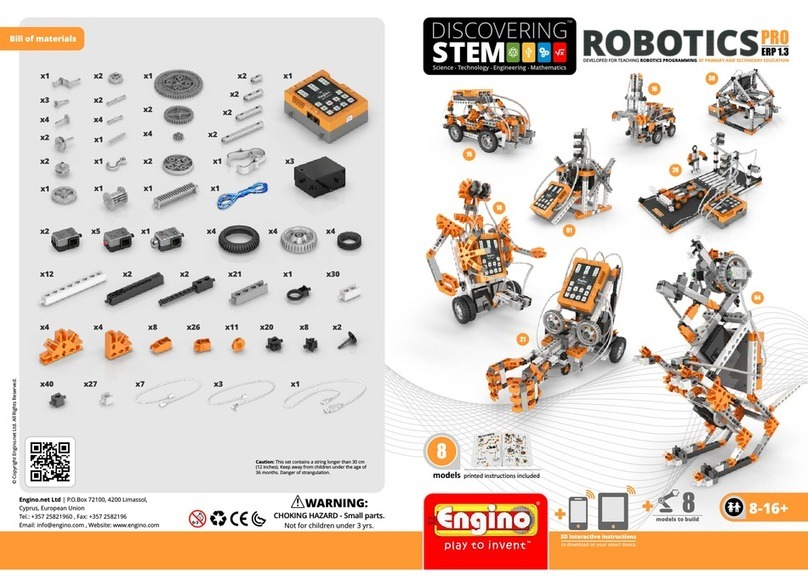B.C. Air PA-28-140 User manual

Every dollar helps!
These manuals are the culmination of more then 10 years of design
and publication and formally sold for $10.00 each. With 54 different
manuals available, that’s a $540.00 value.
Now, due to the worldwide economic collapse, they are my gift to you.
My hope is that you will enjoy these great little airplanes as much as I
have enjoyed designing them for you.
You may build as many planes as you like.
Sell your planes, or give them away.
Tell ALL your airplane loving friends to come to the site and get as
many of the manuals as they like.
If you enjoy these planes, please help to ensure this site stays on-line
and these airplane manuals remain available for all to enjoy. Any
amount you donate is greatly appreciated.
May God bless you and keep you safe.
Thank You & Enjoy!
Wayne

www.bcair.com
Copyright © 2013 B. C. Air Originals
Step By Step Construction Plans.
36 Pages With Over 125 Full Color Photos
showing how to build the
Can be made from most
12 or 16 oz Beverage Cans.
Wingspan: 17”
Length: 14”
Height: 4 1/2”
TOP SECRET
Piper Cherokee
FROM CANS !
PA-28-140

Welcome to the B. C. Air Originals Squadron.
This booklet contains complete step by step instructions for building the B. C. Air
Originals - Piper Cherokee. Before you start building your first plane it is sug-
gested that you review the entire set of plan directions. Once you have previewed
the construction steps you should start collecting the cans that you want to use to
make your first plane. These plans are designed to be used with most any 12 or 16
oz. beverage can. Always use clean, unscratched and undented cans for the best
looking planes.
Since the building of these planes requires the cutting of cans and the use of sharp
tools, CHILDREN SHOULD NEVER ATTEMPT THE CONSTRUCTION OF
THESE PLANES WITHOUT ADULT SUPERVISION AND GUIDANCE.
CONSUMER ACCEPTS ALL RESPONSIBILITY FOR ANY INJURY IN-
CURRED IN THE BUILDING OF THESE PLANES.
It is not necessary to follow all the building steps in the order presented. Such as, if
you want to make the Wings, or the Tail Section first, you can do that and then set
them aside until you need them. However, until you understand the construction of
these planes, it may be easier to follow the steps in the order listed. Your very first
step should be to make a copy of all the templates. All templates are drawn to
scale. Using a sheet of mylar (Clear Plastic) will enable you to re-use your tem-
plates again and again. There is no limit to the number of planes you can build with
these plans.
We, at B. C. Air Originals, will make every effort to assist you in answering any
questions you may have about the construction of these planes. Please feel free to
Thank you for your interest in the B. C. Air Originals and have FUN!
D. P. (Wayne) Mathis

When you print your manuals be sure that your printer is set on it’s MAX
printing area to ensure that all the templates print out to the correct size.
The standard 12 oz Can, here in the US, measures 2 1/2" in diameter. If the
Cans you’re using to make your plane are smaller or larger, then here’s
what you do..... Measure the diameter of your Can and find what percent-
age of 2 1/2" it is.... I.e. If your Can measures only 2 1/4" (in diameter)
then 2 1/4" is = to 90% of 2 1/2" so you would print out all the templates
at 90% instead of at 100%. If your Can measures 3" (in diameter) then 3"
is = to 120% of 2 1/2" so you would print out all of the templates at 120%.
etc.
Some of these models were originally designed in 1984. Since then the
building techniques of these planes has changed over time. I.e. many of the
planes no longer require the use of the wooden former “F-1 & F-2”. We
simply glue the “B-2’s” onto the BACK (BOTTOM) of the Can “B-1” or
use corrugated cardboard in place of the wood. (See http://
www.bcair.com/BT/nwf1.htm and http://www.bcair.com/BT/nf1.htm )
Once you’ve reviewed your manual and you’re ready to start your first
plane, go here > http://www.bcair.com/BT/ < and look over the Builder’s
Tips. These are building tips sent in from builders all over the world. They
will help you to make these planes easier and faster. Bookmark this page as
it is NOT accessible from the main web site.
You can obtain the plastic props used on these planes from your
local Hobby Shop or here’s where I get my props on-line > http://
www3.towerhobbies.com/cgi-bin/wti0091p?&C=QBC&V=MAS <.
Here’s where I get my Wooden Propellers on-line > http://
www3.towerhobbies.com/cgi-bin/
wti0097p?FVSEARCH=PROPELLERS+++&CATEGORY=QB&MANUFACTURER=TOP&submit=Submit+AdvancedSearch
<
Any 5-7" prop, with any pitch, will work on these planes.
http://www3.towerhobbies.com/cgi-bin/wti0097p?
FVSEARCH=PROPELLERS+++&CATEGORY=QB&MANUFACTURER=TOP&submit=Submit+AdvancedSearch

The following is a list of tools and materials I use to build these planes.
You may find that you do not need all of the tools that I use.
Use whatever works best for you.
Push Pin.
Hot glue gun.
Awl (old screw driver sharpened to a point).
Wire cutter. Rat-Tail-File
X-acto knife (hobby knife) (box opener).
Scissors
Small Paper Cutter, Ruler (straight edge).
Felt tip pen (any color).
Needle nose pliers.
Materials -
Aluminum Cans (beer, pop, soda, juice, etc) any 12 oz. size will work.
Bottle caps.
Corrugated Cardboard.
Tape (any kind) & Glue (2-Part Epoxy works best).
Mylar (Clear plastic).
Copper Coated Welding Rod, Music Wire or any other straight wire .
(2 sizes - 1/16” & 3/32”)

Cutting Cans
The building of these planes requires that the Tops and/or Bottoms of beverage cans be
cut off. While you can decide for yourself which method you use to accomplish this,
most builders use a Dremal®Tool in a fashion similar to that shown below.
SEE ALL THE BUILDERS TIPS ON-LINE AT > www.bcair.com/BT
What I’ve done here is taken a piece of
board wood (aprox 12” x 15” x 3/4”) and to
it I’ve attached (screw or glue) Two Blocks
of wood (2” x 2” x 5”) and Two Rails of
wood (1” x 1” x 10”)
Using a Hose Clamp, I’ve secured my
Dremal®Tool to the board. The two
guide rails are used to cradle the can.
A cutting wheel is used to cut the
Bottom and the Top off the Cans.
Again, you can use any other method at your disposal to remove the Tops and Bottoms
of the cans. Use whatever means you feel most comfortable with.
ALWAYS USE PROTECTIVE HAND & EYE GEAR WHEN CUTTING CANS!
In ALL cases, cut
the Bottom off the
Can FIRST, then
cut the Top off.
Get as much of the
Can as possable.

Another Way Of Cutting Cans
Once you’ve selected which Cans your plane will be made out of, take one Can and hold it firmly at
it’s bottom. Using your wire snips, cut through the ring at the top of the Can.
Now grab the ring with your wire snips and PULL the top off the Can. The top will normally tare off
right where the Can begins to taper inward to the ring.
Continue PULLING until the top of the Can comes off. Then cut down the side of the Can with your
scissors. Next use a smaller scissor to cut the bottom off the Can.
Use a straight edge, or a paper
cutter to trim the edges smooth.
Trim Can to 3 5/8” x 8 1/4”
SEE ALL THE BUILDERS TIPS ON-LINE AT > www.bcair.com/BT
(This is the method I used to make this plane.)
6

Once you’ve selected which Cans you’ll
be using to make your plane out of,
Remove the Pull Tabs from all Cans and
STEP # 1
This Plane takes a total
of 10-11 Cans to make.
Pull Tab
STEP # 2
www.bcair.com
cut the Tops and Bottoms off All Cans and
open them up as shown here. (See Page 6)
GETAS MUCH OF THE
CAN AS POSSIBLE
STEP # 3
Cut out Template # 1, (CPF) page
33, from a piece of corrugated card-
board.
CPF
<--Corrugation Runs-->

STEP # 4
STEP # 6
Score CPF where indicated.
CPF
CPF
Bring the sides, front and back of the CPF
up and glue them into place as shown.
CPF
CPF
<--Corrugation Runs-->
STEP # 5
Cut TWO pieces of corrugated Cardboard 1 1/2” x 3 3/8”
and place them both in the bottom of the CPF.
NOTE that the corrugation of these two pieces
runs from Side to Side, NOT Front to Back.
CPF
<--Corrugation-->
Runs
(I used my Hot Glue Gun for this.)

STEP # 7
www.bcair.com
STEP # 8
<--Corrugation Runs-->
<--Corrugation Runs-->
Template # 2
EM
EM
EM
EM
EM
WSF
WSF
WSF
STEP # 9
Template # 3
WSF
Cut Templates # 2 & 3 (Page 33) from corrugated cardboard as shown.
Note how WSF
fitts onto EM.
Glue EM inside
CPF as shown.
CPF
Glue WSF onto EM as shown.
(I used my Hot Glue Gun for this.)

STEP # 10
STEP # 11
Cut TWO pieces OF THE FRONT
END of Template # 2 (EM) from
corrugated cardboard.
EM
Glue these two pieces to each
side of the EM as shown.
Take a piece of 3/32” Rod, 5” long, and glue it
into the EM. Leave 2” of the Rod sticking out
as shown.
2”
(I used my Hot Glue Gun for this.)
(I used contact cement for this.)
<--Corrugation Runs-->

STEP # 12
STEP # 13
Cut Template # 4 (TC - page
34) from the Two Cans that you
married together in Step # 12.
Place strips of clear tape on the
INSIDE of the TC and Score
the TC on the INSIDE, where
shown.
(The tape will help to keep the
Cans from cracking and break-
ing apart.)
Can
Cellophane Tape
Double-Sided Tape
Glue on INSIDE
Marry Two Cans, from Step # 2, together as shown here.
Template # 4

STEP # 14
Shape the TC and hold it’s shape with
a piece of clear tape on the UNDER
SIDE where the Cans over lap. Glue
on the INSIDE.
TC
STEP # 15
Cut out Template # 5 (TCF), page 33, from
corrugated cardboard and put a “thin” beed
of hot glue around the edge. Insert the TCF
into the TC and glue it in place.
www.bcair.com
TC
TCF
TCF
(I used contact cement for this.)
(I used my Hot Glue Gun for this.)
Completed Tail Cone
Template # 5
<--Corrugation Runs-->
<--Corrugation Runs-->
www.bcair.com

STEP # 16
STEP # 17
Glue the TC on to the back end of the CPF.
CPF
CPF
Use your BLACK Sharpie and blacken the front of the EM.
EM CPF
WSF
(I used Hot Glue to do this.)

STEP # 18
Take any clear 1
liter plastic bottle
and remove the
label (A). Mark
the bottle as
shown (B). Cut
the bottom of the
bottle off (C), then
cut up the side of
the bottle (D) and
cut the top off (E).
Template # 6
WS
WS
ABC
DE
STEP # 19
Trace Template # 6, page 36, onto the plastic
bottle as shown and cut out the WS.
STEP # 20
Paint the INSIDE of the WS black.

STEP # 21 Place WS in position (on the CPF) and mark the
CPF where slits will be needed for the WS Tabs.
CPF
WS SLIT
WS SLIT
Trim EM if necessary.
EM
EM
STEP # 22 Glue WS in place on top of EM and CPF as shown.
WS
STEP # 23
Trace Template # 7, CPC (page 35),
onto a Can and cut out the windows
as shown.
CPC FIRST, “SCORE” the windows with a
ball point pen.
NEXT, cut a small hole in the middle of
the window, using your X-Acto knife.
NEXT, use a small scissors and cut,
from the hole, to each corner of the
window. (See next page).
(I used Hot Glue for this.)
www.bcair.com

STEP # 24 (CONT)
(Cut, from the hole, to
each corner of the
window.)
Now “bend INWARD”
each piece of window
Can and it should break
off cleanly.
Repeat Step 23 for
each window.
Cut out the remainder
of the CPC.

STEP # 25
Glue CPC in place
onto the WS, TC and
CPF as shown.
WS
CPC
TC
EM (I used Hot Glue and 2-
Part Epoxy for this.)
STEP # 26
Cut out Template # 8,
EC (page 35), and glue
it into it’s shape as you
did with the TC.
Glue the EC onto the
CPC and WS as
shown. (I used Hot
Glue on the INSIDE for
this.)
EC
CPC
WS
www.bcair.com

STEP # 27
Take seven (7) Pull Tabs and glue them into a
stack. Use a strip of tape to hold them in place
until the glue is dry. Make Two (2) stacks.
These will be the Engine Cylinders.
Glue on the INSIDE
STEP # 28
(I used contact cement (E6000) to do this.)
Glue one Engine
Cylinder to either side
of the EM as shown.
(I used 2-Part Epoxy
for this.)
EM

STEP # 29
Trace Template # 9, (page 34), FEC,
onto the INSIDE of a Can bottom and
cut it out. (SEE NEXT PAGE)
Glue the FEC onto the front of the EC.
Trim the front of the EC to get a tight fit. FEC
FEC
FEC FEC
EC
EC
EC
EC
FEC
(I used 2-Part Epoxy to do this.)
www.bcair.com
Table of contents
Other B.C. Air Toy manuals
